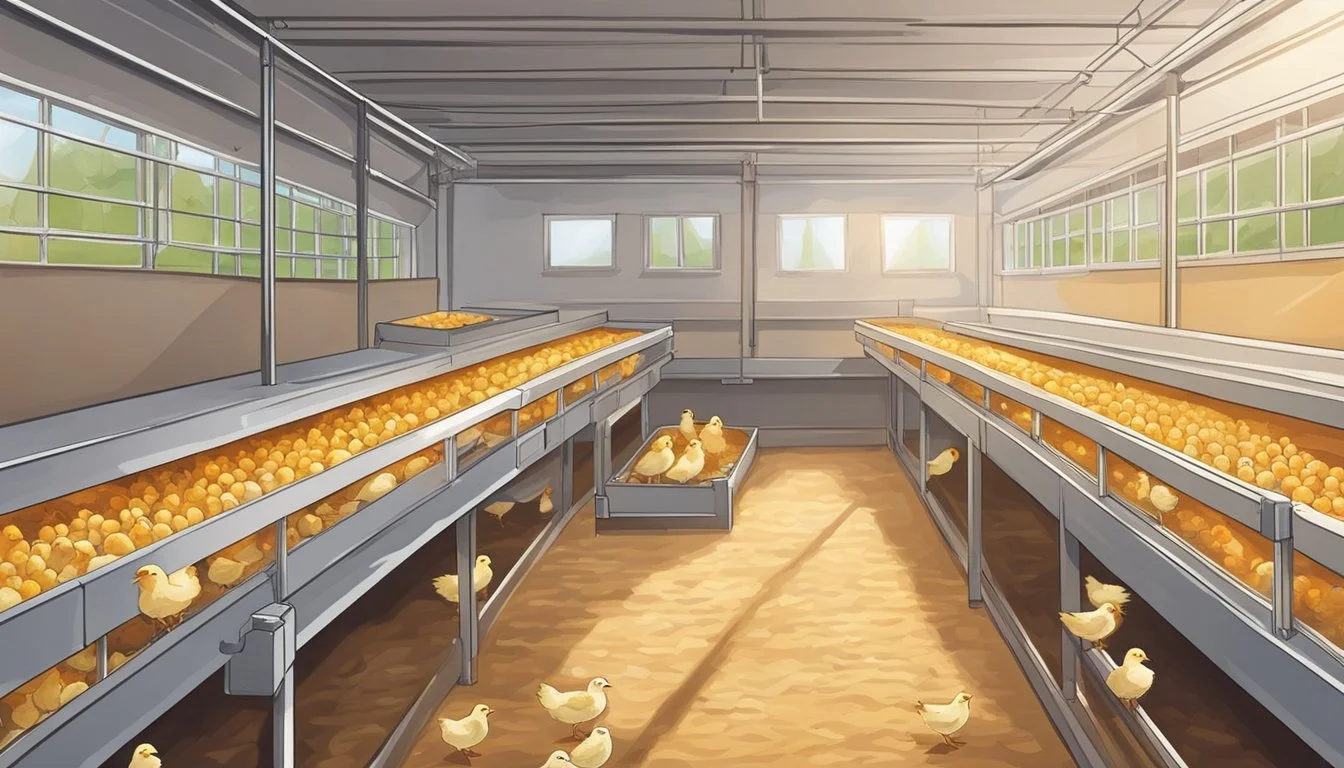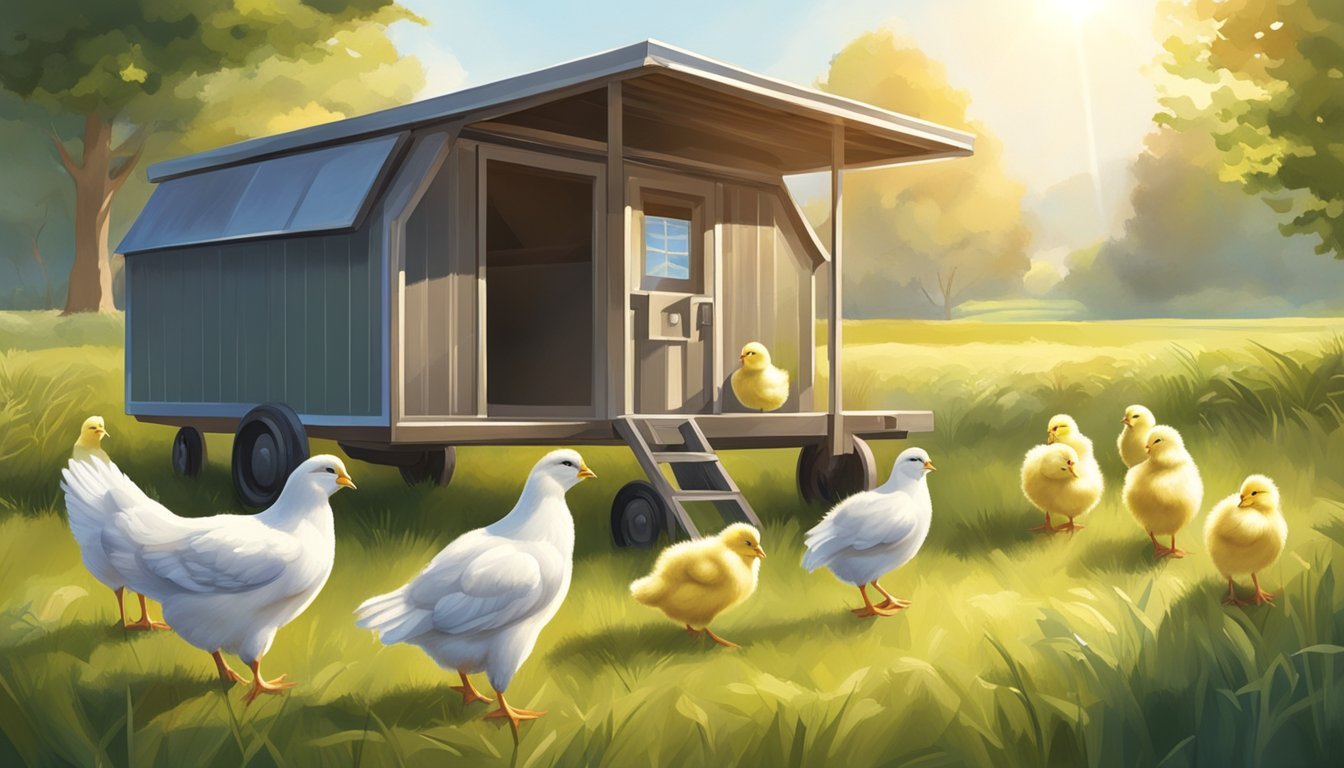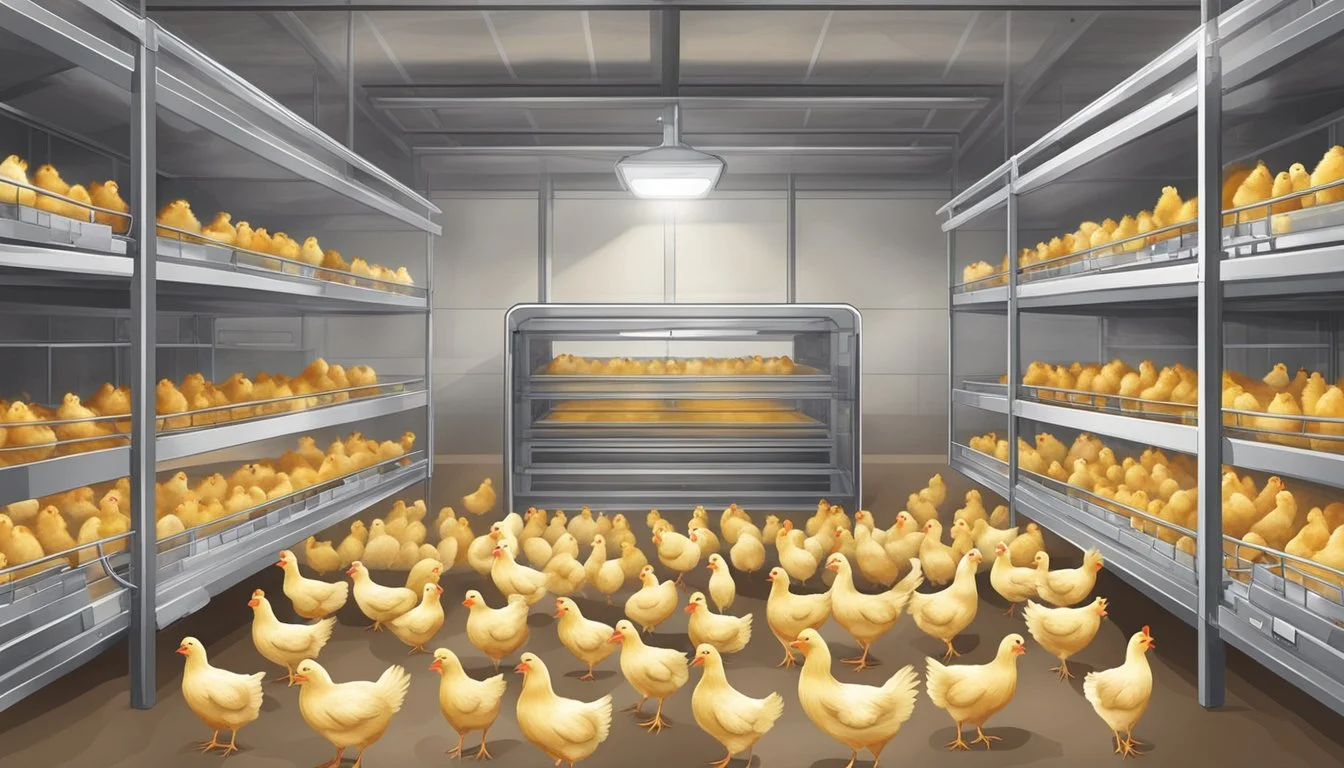The Ultimate Guide to Using a Mobile Brooder House for Optimal Chick Growth on Homesteads
Raising poultry chicks on a homestead requires careful planning and the right equipment to ensure the birds' health and growth. A mobile brooder house presents an effective solution for accommodating the unique needs of young chicks. It not only provides a controlled environment vital for their early life stages but also offers the flexibility to be moved to different locations as needed. This versatility allows homesteaders to manage their space effectively and expose chicks to various environments, which can be beneficial for their upbringing.
Using a mobile brooder house involves understanding space requirements, temperature control, and the necessary supplies to create a conducive living space for the chicks. Typically, chicks require a warm area especially in their first weeks of life when they are most vulnerable. The brooder must be able to maintain a consistent and suitable temperature, decreasing it gradually as the chicks grow and develop feathers. Supplies such as a heat source, bedding material, feeders, and waterers form the core of a mobile brooder's setup.
Selection of the mobile brooder house also plays a critical role in the success of raising poultry chicks. The choice should ensure sufficient space, protection from predators, and the ability to maintain a clean environment. A well-planned brooder serves as a foundation for healthy chicks, which can later transition to outdoor pens or free-ranging with greater resilience and adaptability.
Choosing the Right Brooder Setup
When setting up a brooder for poultry chicks, it is critical to prioritize the chicks’ safety, comfort, and growth requirements. The right setup includes understanding basic needs, choosing an optimal location, and selecting the appropriate size and supplies for your mobile brooder house.
Understanding Brooder Basics
A brooder is essentially a chick's first home where it can stay warm, safe, and grow during the crucial early weeks of life. The right setup must maintain a steady temperature, provide enough space for the chicks to grow, and be constructed of suitable materials to keep them secure.
Temperature: Aim to start at 95°F (35°C) for the first week, reducing by 5°F (3°C) each week until chicks are acclimatized.
Space requirements: Initially, provide at least 6 inches of space per chick; gradually increase to 1 sq. ft by 6 weeks of age.
Security: The brooder should be enclosed with hardware cloth or a similar barrier to protect from predators.
Selecting the Ideal Location
Choosing a location for your brooder involves considering protection from the elements and ease of access for monitoring and maintenance. The site must be:
Dry: Moisture can lead to disease; never place a brooder in a damp area.
Protected: Shield your brooder from wind and direct sunlight.
Accessible: Ensure you can reach the brooder easily for regular check-ups and cleaning.
Building or Acquiring Your Brooder
Whether undertaking a DIY brooder project or purchasing a pre-made chicken brooder, the container must be sturdy, cleanable, and size appropriate. Typical materials for constructing a brooder at home include:
Wood panels or plywood.
Sturdy plastic containers.
Old furniture re-purposed with hardware cloth for security.
Purchasing a brooder can be done conveniently through agricultural suppliers or online platforms like Amazon.
Essential Brooder Supplies
Outfitting your brooder with necessary supplies ensures optimal chick development. Items to procure include:
Heat source: such as heat lamps or EcoGlow heaters, monitored by a thermometer.
Bedding: Pine shavings are commonly used for absorption and comfort.
Feeders and waterers: Specifically designed for chicks to prevent drowning and food wastage.
Cleaning materials: facilitate regular maintenance to keep the environment healthy.
By adhering to these guidelines, you can create a brooder setup that will support the well-being and growth of your poultry chicks, laying a strong foundation for their transition to the coop.
Creating a Safe and Comfortable Environment
To raise poultry chicks successfully, the brooder house must be a haven that simulates the warmth and protection of a mother hen. Attention to detail in temperature control, bedding selection, and ventilation can drastically improve the chicks' survival rates and overall well-being.
Maintaining Proper Temperature
The chicks' brooder house requires a consistent and appropriate level of warmth, especially in the early stages of life when they are unable to regulate their body temperature. Heat lamps are the most common source of heat, but it's crucial to hang them securely to prevent contact with bedding, which could lead to fires.
Temperature Range: Start at 95°F for the first week and decrease by 5°F each subsequent week until reaching room temperature.
Use a thermometer to monitor the heat within the brooder house, ensuring a consistent environment to prevent chilling or overheating the chicks.
Optimizing Bedding and Cleanliness
Good bedding material is essential for both comfort and hygiene in a mobile brooder house. Use pine shavings as they are excellent at absorbing moisture and are comfortable for chicks.
Avoid using materials like straw, newspaper, or cedar shavings, as these can either fail to absorb droppings effectively or can be harmful.
Change bedding frequently to maintain cleanliness, reducing the risk of diseases and keeping ammonia levels low. A clean brooder is vital to prevent the build-up of dust and pathogens.
Ensuring Adequate Ventilation
Proper air circulation is necessary to keep the air fresh and remove excess moisture and ammonia, which can accumulate from droppings.
Ventilation should be controllable to prevent direct drafts on the chicks whilst still allowing for stale air to be replaced with fresh air.
Strategic placement of vents or windows can provide enough airflow to reduce humidity and airborne pathogens without creating cold spots.
Nutrition and Water for Chicks
Optimal nutrition and access to clean water are crucial from the very start for the health and well-being of poultry chicks. A well-balanced diet and hydration plan will support their rapid growth during the early stages of their life.
Choosing the Right Feed
Poultry chicks require a high-protein diet for proper growth – chick starter feed is specifically formulated to meet these needs. The feed typically contains about 18-20% protein and ensures chicks receive the necessary nutrients during their first weeks of life. It is available in both medicated and non-medicated options; the medicated type contains amprolium to protect against coccidiosis, a common intestinal disease.
Setting Up Feeders and Waterers
Feeders should be easily accessible and designed to minimize waste. A rule of thumb for space allocation is:
Week 1-4: 6 inches per chick
Week 4-8: 1 square foot per chick
For waterers, cleanliness is paramount to prevent disease. They should be:
Refilled daily with clean water.
Placed at back level to avoid contamination with bedding.
Both feeders and waterers should be checked frequently for refilling and to ensure the health of your chicks.
Understanding Chick Hydration and Diet
Chicks should always have access to clean water that is free of contaminants. Water intake is essential for digestion and absorption of nutrients from their diet. Complementing their feed with grit helps chicks break down food effectively, especially if they are being offered any type of treats. Over time, chicks will transition from starter feed to grower feed as their dietary requirements evolve.
Health Monitoring and Preventing Issues
In the critical initial stages of a chick's life, vigilant health monitoring and the prevention of issues are paramount for ensuring their survival and growth. Maintaining optimal conditions within the mobile brooder house is key to raising a healthy poultry flock.
Observing Chicks' Behavior and Health
Key Behavioral Indicators: Chicks that are thriving exhibit certain behaviors. A keeper should look for active foraging, consistent eating and drinking, and regular sleeping patterns. Any deviation from these behaviors, such as lethargy or lack of appetite, may signal health issues.
Activity Level: Chicks should move around the brooder freely and with purpose.
Eating Habits: Consistent pecking at feed indicates good health.
Sleeping Patterns: Healthy chicks sleep in short spells and wake up alert.
Signs of Illness or Stress:
Lethargy or inactivity
Disinterest in feed or water
Unusual chirping: High-pitched or constant chirping can indicate distress.
Abnormal feces: Watch for signs of "pasty butt," a condition where droppings stick to the chick and can lead to blockage and infection.
Environmental Conditions and Cleanliness:
Temperature: A brooder heater should maintain a steady temperature of around 95 degrees Fahrenheit in the first week, reducing by approximately 5 degrees each week to adapt to chicks' maturing body temperature control.
Brooder Cleanliness: Regular cleaning to prevent buildup of droppings and reduce the risk of diseases. Daily checks are required to ensure the living space is dry and free from contaminants.
In sum, constant observation of chick behavior, coupled with rigorous maintenance of environmental conditions, is essential in the early life of poultry to prevent health issues and ensure robust growth.
Integrating with the Flock and Transitioning Outdoors
Successfully integrating poultry chicks into an existing flock and transitioning them outdoors requires careful planning and execution to ensure security and harmony in the backyard chicken environment.
Acclimating Chicks to the Flock
When chicks reach the appropriate age—usually around 4 to 6 weeks—they should start getting acclimated to their future flock mates. This process should be gradual to prevent stress and bullying.
Initial Introduction: It's best to introduce them to the flock in a secure, but visible area, such as a separate pen within the coop. This allows both chicks and the existing flock to see and become accustomed to each other safely.
Supervised Interaction: After a week or so of separate but visible housing, allow for supervised interactions during the day. Watch for aggressive behaviors from the hens towards the chicks.
Nighttime Integration: If the flock appears to accept the new members, try placing the chicks on the roost with the hens at night. They wake together, reducing the chance of conflict since chickens are less territorial at roost time.
Moving Chicks to the Coop or Outdoor Brooder
Once the chicks are feathered and demonstrating the ability to regulate their body temperature, they're ready for the transition to a coop or outdoor brooder. Follow these steps to provide them protection and comfort in their new environment:
Provide Adequate Space: Ensure enough space is available in the outdoor brooder—1 square foot per chick until 8 weeks old, followed by 2 square feet from 8 to 12 weeks.
Keep It Secure: Protection from predators is vital. The coop or outdoor brooder should be secure, with sturdy fencing and appropriate cover.
Establish Routine: Establish a consistent feeding and watering routine to help the chicks adapt smoothly to their new outdoor settings.
Monitor Climate: If the weather is harsh, provide supplemental heat or shelter until they are fully acclimated to living outdoors full-time.
Brooder Maintenance and Best Practices
Maintaining a mobile brooder house is critical for the health and growth of poultry chicks. This section focuses on effective strategies for routine cleaning, adapting the brooder to accommodate growing chicks, and ensuring their protection from predators and diseases.
Routine Cleaning and Sanitization
Regular cleaning is essential to prevent disease and maintain a healthy environment. Developing a daily schedule for removing feces and refreshing the bedding can substantially reduce contamination risks. Weekly tasks should include:
Cleaning: Thoroughly removing all bedding and waste.
Sanitizing: Using safe, poultry-approved products to clean the brooder.
Items to sanitize include feeders, waterers, and any surfaces with which the chicks come into contact. Properly disposing of old bedding and feces is crucial to prevent attracting pests and parasites.
Upgrading Brooder as Chicks Grow
Chicks require increasing space as they develop. Space recommendations:
0-4 weeks: At least 6 inches of space per chick.
4-8 weeks: Expand to 1 square foot per chick.
8-12 weeks: Increase to 2 square feet per chick.
A mobile brooder should allow for easy modification in size or structure to meet these growing needs without overcrowding, which can lead to stress and heightened risk of disease transmission.
Protecting Against Predators and Diseases
The security of the brooder is paramount to safeguard chicks from external threats.
Predator-proofing: Ensure the brooder box is secure with durable materials. Covers should be sturdy and fit snugly to dissuade predators like cats or dogs.
Biosecurity: Implement measures such as quarantine for new birds and limit human traffic to reduce disease transmission.
Monitoring: Regularly inspect for signs of illness, injury, or stress among the flock to respond promptly to any health concerns.
Pest control: Eliminate and prevent mites, lice, and other parasites that can be deadly to poultry chicks.
Adhering to these best practices will help maintain cleanliness, promote flock health, and prevent the spread of disease in a mobile brooder house.
Homesteading Tips for Raising Poultry
The success of raising poultry on a homestead often pivots on thorough preparation and informed management practices. This section provides crucial guidance on selecting and breeding the right flock, optimizing the use of brooder houses in constrained environments, and managing supplies in a cost-effective manner.
Selecting and Breeding for Your Homestead Flock
Choosing the right chickens for a homestead flock involves considering the purposes they will serve, whether for egg production, meat, or both. Hens known for their prolific egg-laying include breeds such as the Rhode Island Red and the Leghorn. For those interested in meat, the Cornish Cross is a popular choice due to its fast growth rate. Breed selection should align with the homesteader's goals and the environmental constraints of their property.
Breeding provides the opportunity to enhance the flock’s quality. One should maintain a diverse gene pool and monitor breeding pairs for desired traits. Hatching eggs can be done naturally by broody hens or by using an incubator. Each method necessitates diligent care, such as maintaining proper temperature and humidity levels for successful hatching.
Using Brooder Houses in Urban and Small-Space Settings
In urban settings or locations with limited space, a mobile brooder house, such as a modified rabbit hutch or storage bin, can be an effective solution. They allow for the secure raising of chicks until they're ready to join the main flock. The brooder should be predator-proof, made possible by materials like hardware cloth, and should keep chicks warm and safe.
Brooder Type: Storage Bin
Material: Plastic
Typical Size (LxWxH): 24"x18"x18"
Capacity: 5-10 Chicks
Brooder Type: Rabbit Hutch
Material: Wood/Metal
Typical Size (LxWxH): 36"x18"x20"
Capacity: 10-15 Chicks
One must ensure that the space is adequately heated, using heat lamps spaced safely away from flammable materials like straw or hay. Adequate space for movement and access to chick feeders and water containers should be provided.
Sourcing and Managing Supplies Economically
A homesteader must be resourceful when it comes to acquiring and managing supplies. Bulk purchasing of feed and bedding can lead to significant savings; outlets like Amazon or local farm supply stores often offer competitive pricing. Additionally, DIY solutions for feeders and waterers using repurposed items can cut costs.
Efficient organization is vital for small spaces. Storage solutions, such as shelving or stackable bins, can maximize the utility of limited areas for storing supplies like paper towels, which are essential for maintaining cleanliness in the coop. Further economies can be achieved by preparing homemade feed or building one’s own coops and brooders from recycled materials.




